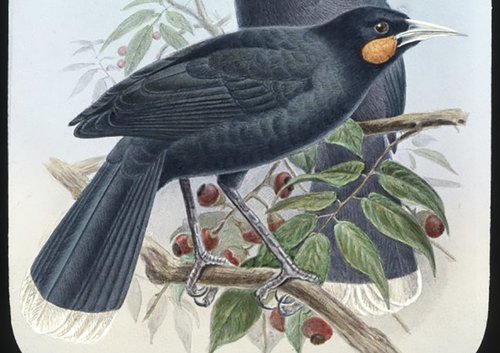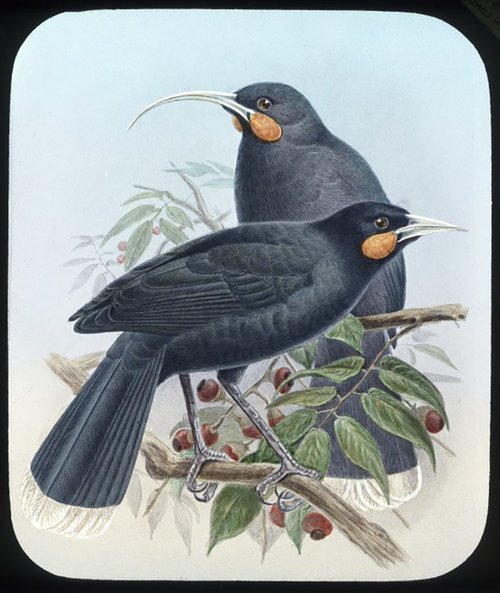
By Sarah Johnston
One of the most often requested items held in the collections of Ngā Taonga – and certainly our most requested sound recording – is the re-creation of the call of the extinct huia bird, recorded in the late 1940s by Hēnare Hāmana, who had been involved in expeditions to find the rare bird as a young man around the turn of the 19th century.
The last authenticated sighting of a huia is generally believed to have been in 1907 in the Tararua Ranges, north of Wellington. Sound recording technology was in its infancy when the huia died out, so there are no recordings of the actual bird call itself. Mr Hamana’s remembered re-creation of the call is the closest thing we have.

Huia birds, male and female.
Harris, Esme, fl 1890-1899 : Photographs. Ref: PA11-046-11. Alexander Turnbull Library.
A recent digitisation of a 1990s radio series by naturalist Matthew Lark, has shed more light on the origins of this recording. In this episode on the huia, Matthew interviewed Robert Batley, who is heard also on the earlier recording. He explained how he and Mr Hāmana drove from the central North Island to the Columbus Recording Studios in Wakefield Street, Wellington in 1948 (or 1949) and there recorded the huia calls on a 78 rpm disc.
Copies of Mr Hamana’s recording have been circulating widely for many years. Excerpts from it can be heard in several places online and it has been broadcast by RNZ in various programmes over the years – even featuring occasionally as the famous 7:00am bird call before Morning Report on RNZ National.
However, the tale of how it came to be recorded had been forgotten, so when journalist Kate Evans contacted us in 2016, some research was called for to unpick the story behind it.
Kate was writing an article about the huia recording for New Zealand Geographic‘s ‘Artefacts’ column. She was keen to know more about the origins of the recording – as was I. We don’t hold the original recording in our collection, but rather a taped copy probably made in the 1960s. On listening to it, you can tell by the sound of surface crackle and hiss that it is a copy of a recording that had been made originally on an acetate or lacquer disc. This pointed to an original recording date probably prior to the mid-1950s, when tape recording technology took over from discs. We didn’t know when or where it was originally recorded, so together through the magic of the internet, the online records of several museums and libraries, phone calls and emails, Kate and I began to unravel the tangled tale of the provenance of the many copies in circulation, until we wound our way back to the 1940s.
We learned the recording was made by two men from Moawhango, near Taihape. The man who introduces the recording is R.A.L. (Robert) Batley, who was from a local Pākehā family that had been early settlers in the region. He in turn introduces Hēnare Hāmana (also known as Harry Salmon) who makes the imitation huia calls. As a young man, Hēnare had been part of an expedition to try and find any remaining huia in the Ruahine Ranges. He and several other men who were good at imitating the bird’s call went along, as the call was one way that huia had traditionally been lured. These expeditions were sadly unsuccessful and by the 1940s the bird was considered extinct.
Robert Batley was a local historian and author, and in 1949 he decided it would be good to record for posterity the closest thing left to the call of the bird. So he organised for himself and Mr Hāmana – who was now in his 60s, to go to Wellington and make this recording.
What happened after this is unclear – certainly it seems several copies of the disc were made. In a letter to The Listener magazine in 1976, Mr Batley explained that one was given to the Wildlife Service (a forerunner of the Department of Conservation) but that many years later, he reacquired this disc from them.
By the mid-1950s, tape recording technology was now in use in New Zealand and taped copies of the recording by Mr Batley and Mr Hāmana appear to have been circulated quite widely among bird call enthusiasts, and it is one of these that Ngā Taonga holds. Journalist Kate Evans even found a copy in a natural history library in the United States, where it has been the inspiration for work by American writer and ecologist Dr Julianne Warren.
Kate was keen to see if an original disc was still in existence and made contact with the Batley family. She learned the original disc that Robert Batley re-acquired from the Wildlife Service had been deposited with his papers after his death in 2004, with Whanganui Museum – and they were able to provide a photo of it for her article which you can read here.
The sad tale of the huia holds a great deal of fascination for many people – both Māori and Pākehā, here in Aotearoa and also overseas. At Ngā Taonga we handle many requests from people who want to hear recordings from our Sound collection. In the case of the huia, these might be ornithologists, academics interested in aspects of extinction, or artists and musicians inspired by the melancholy idea of being able to hear the call of the bird that has long been silenced.
For eye witness accounts of some of the last sightings of the huia, I recommend to researchers that they listen to this wonderful radio documentary from the 1960s, also held in our archives, simply called The Huia.
This recording was produced by broadcaster Alwyn Owen, later of Radio New Zealand’s “Spectrum” fame. In it he talks to various people about the last days of the huia and how it came to die out. The programme begins with a haunting poroporoaki, or traditional Māori farewell, by broadcaster Reverend Kingi Ihaka (Te Aupouri).
As a result of Kate’s enquiry and our joint research, we now have a much richer understanding of the origins of this important recording, and we have been able to fully identify Mr Batley and Mr Hāmana. Mr Batley’s name had disappeared altogether from many institutions’ notes about the huia recording, and Mr Hāmana’s name had gone through several spelling variations over the years. It is thanks to the skill and foresight of these two men that we can still hear an echo of this lovely, long-lost bird which continues to inspire people and it is good to be able to correctly attribute the recording to them once again.
Audio from Ngā Taonga Sound & Vision Radio Collection, all rights reserved. To enquire about re-use of these items please contact sound@ngataonga.org.nz